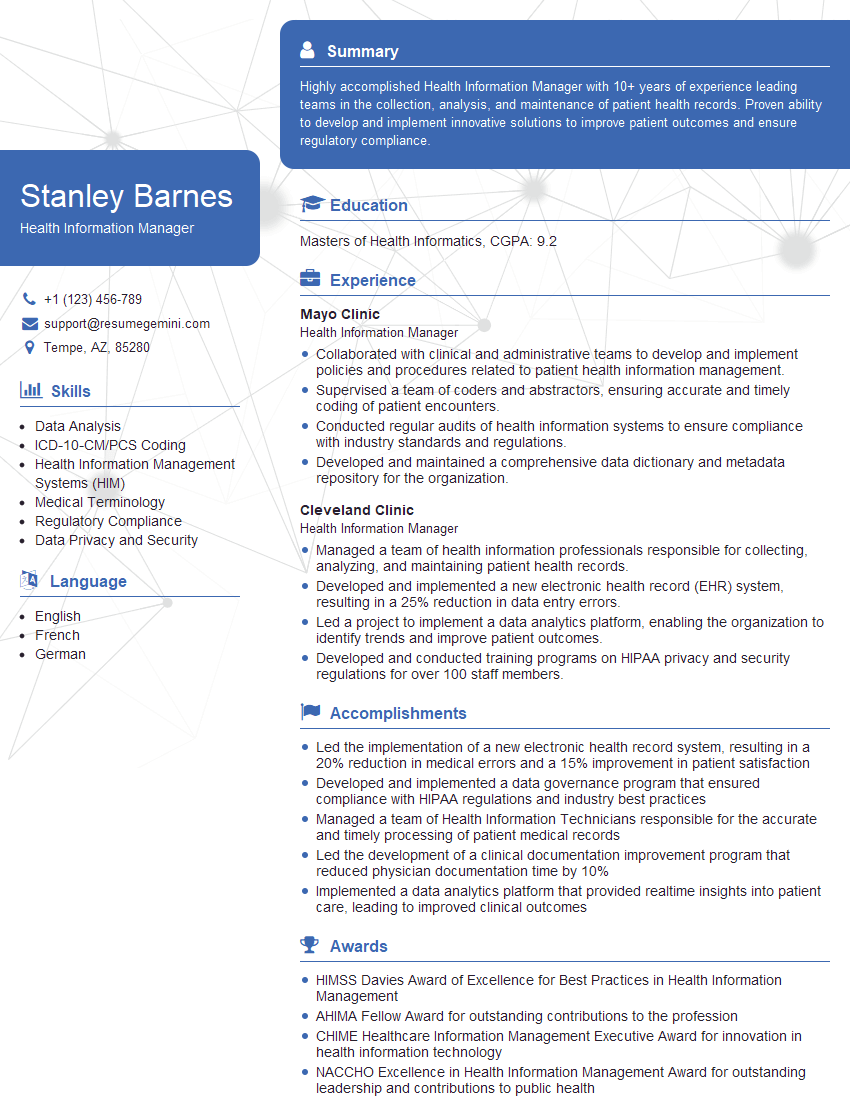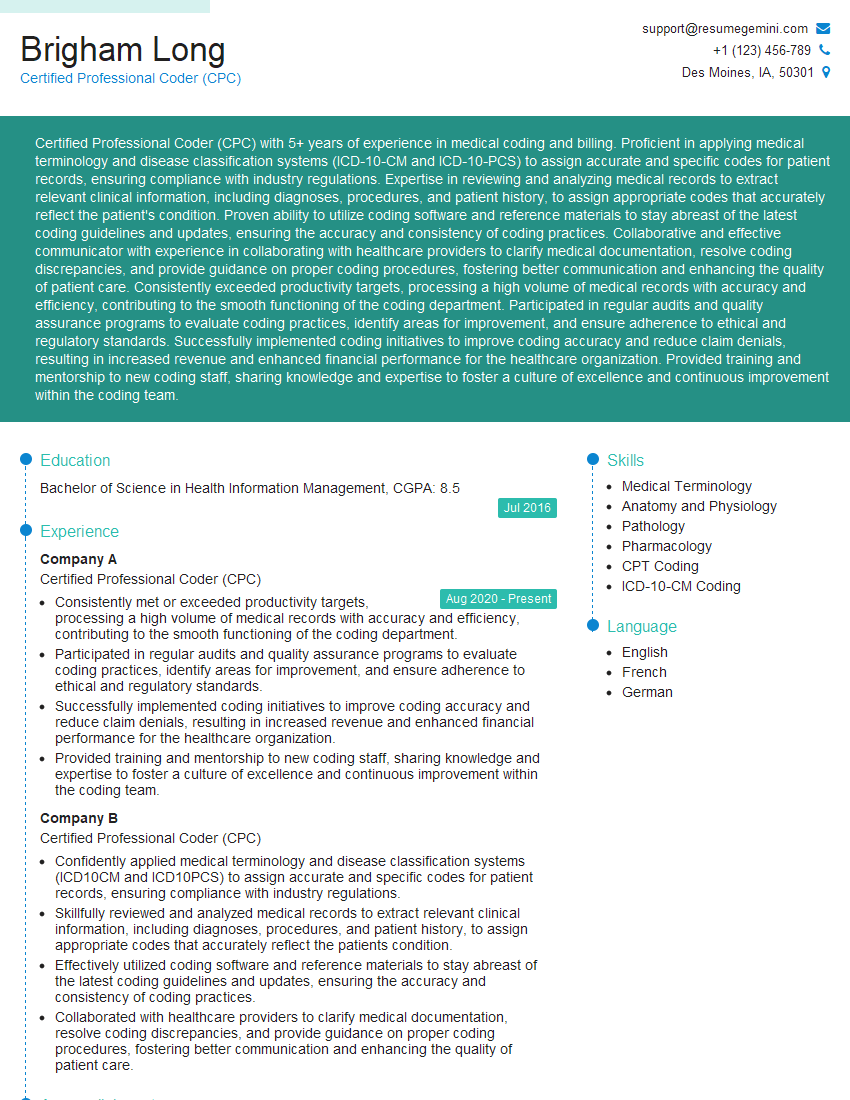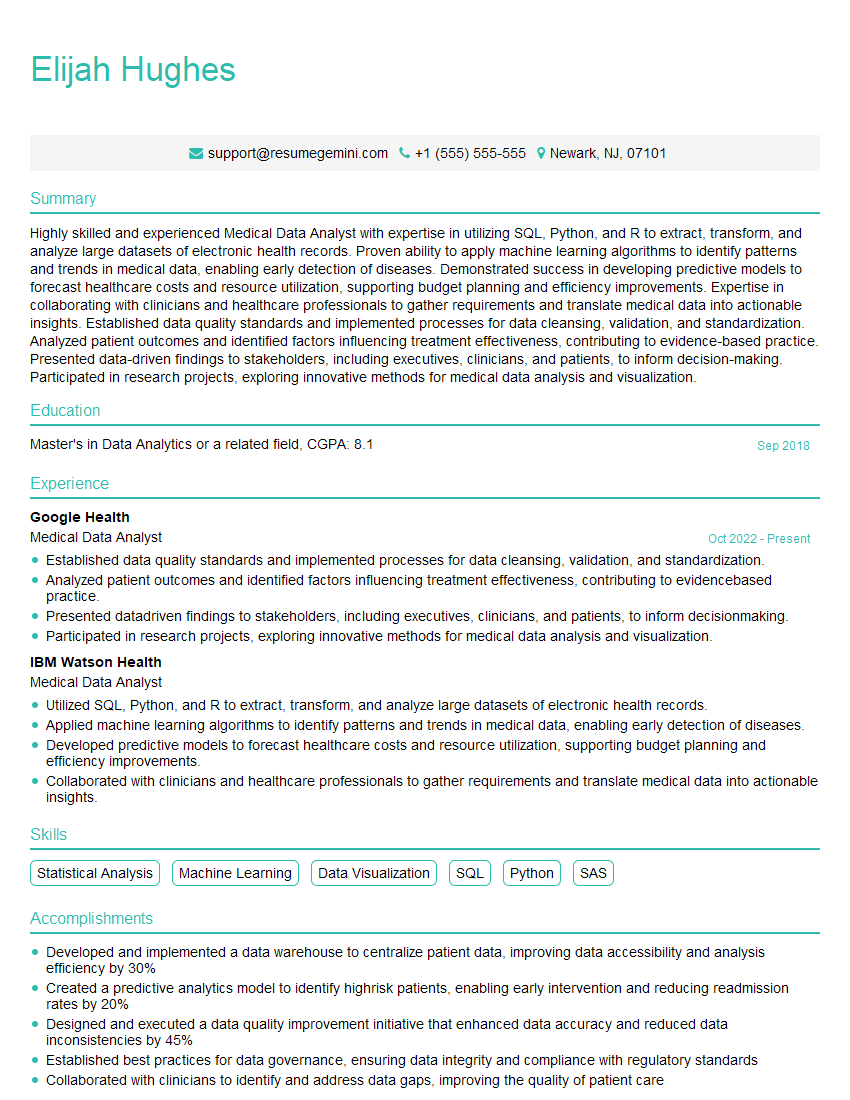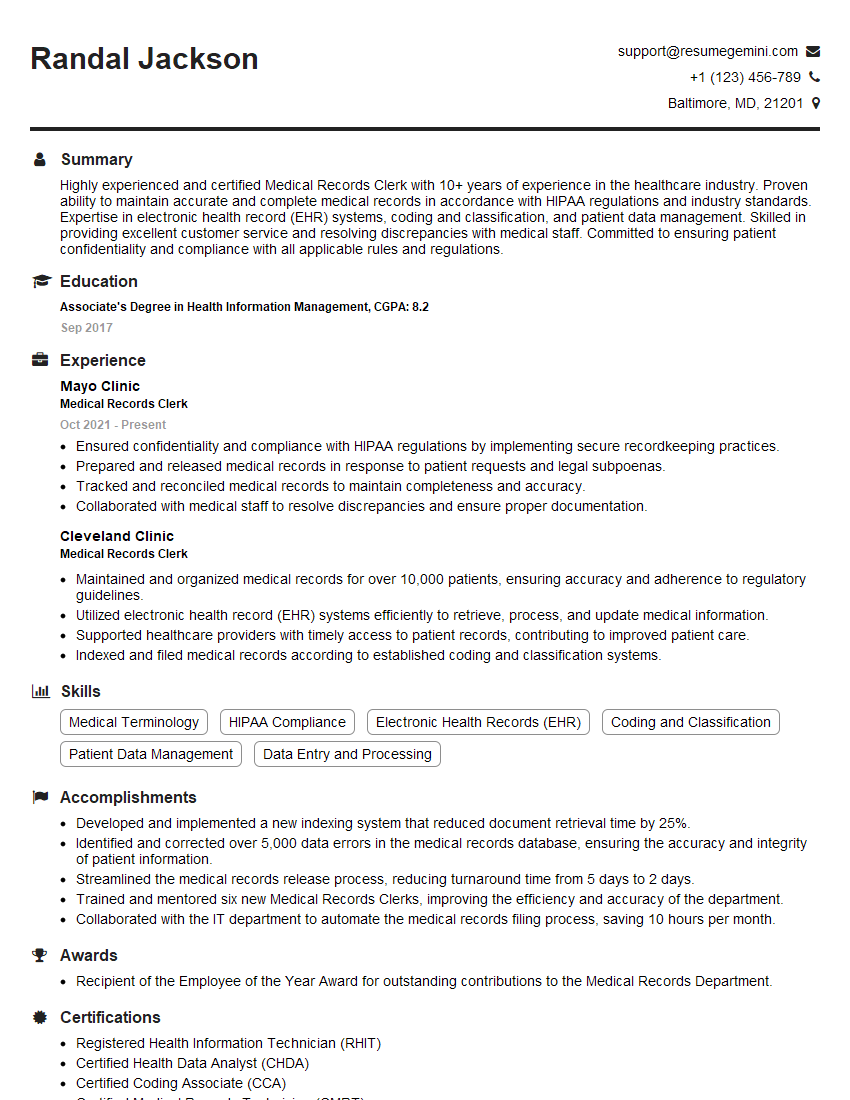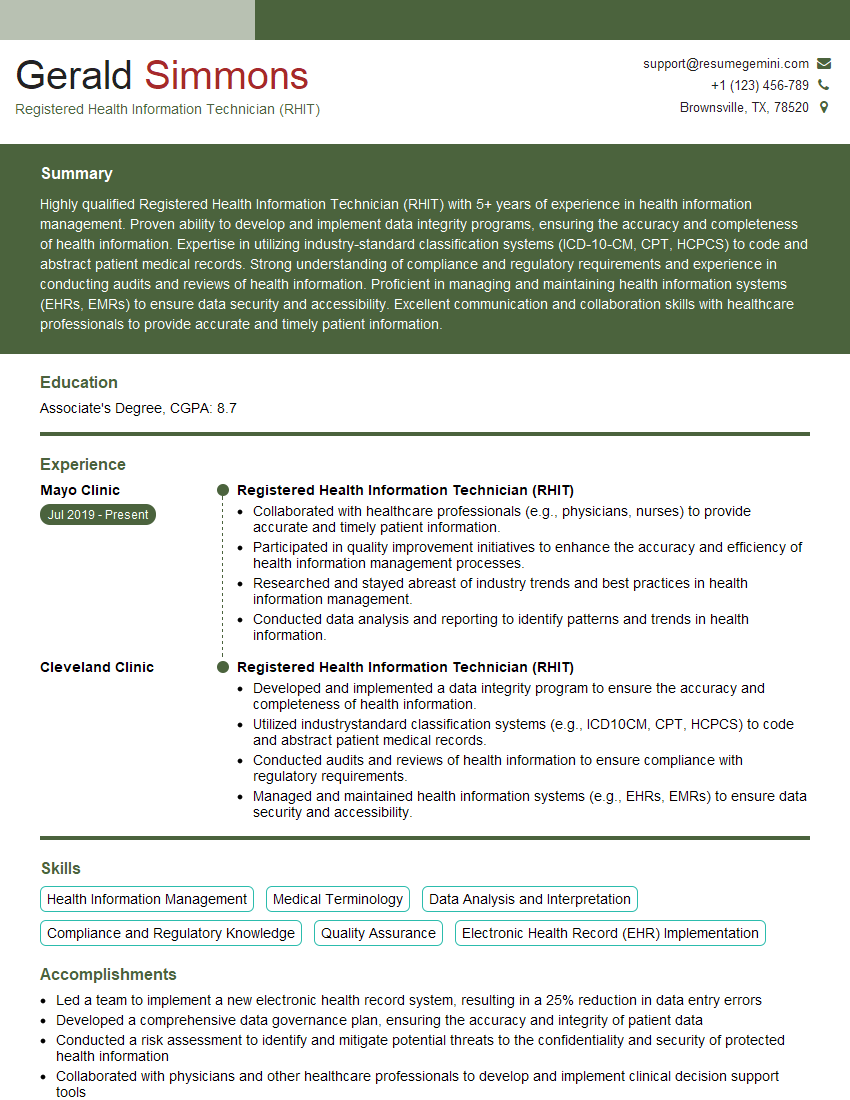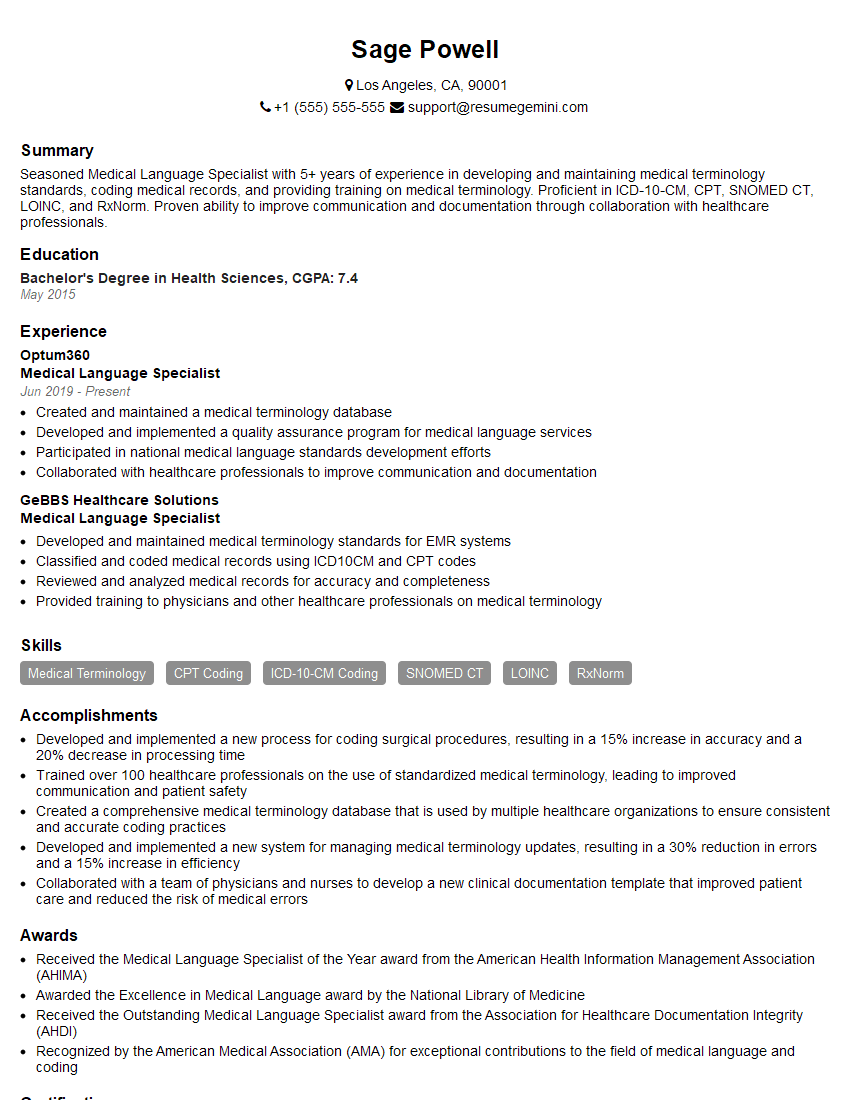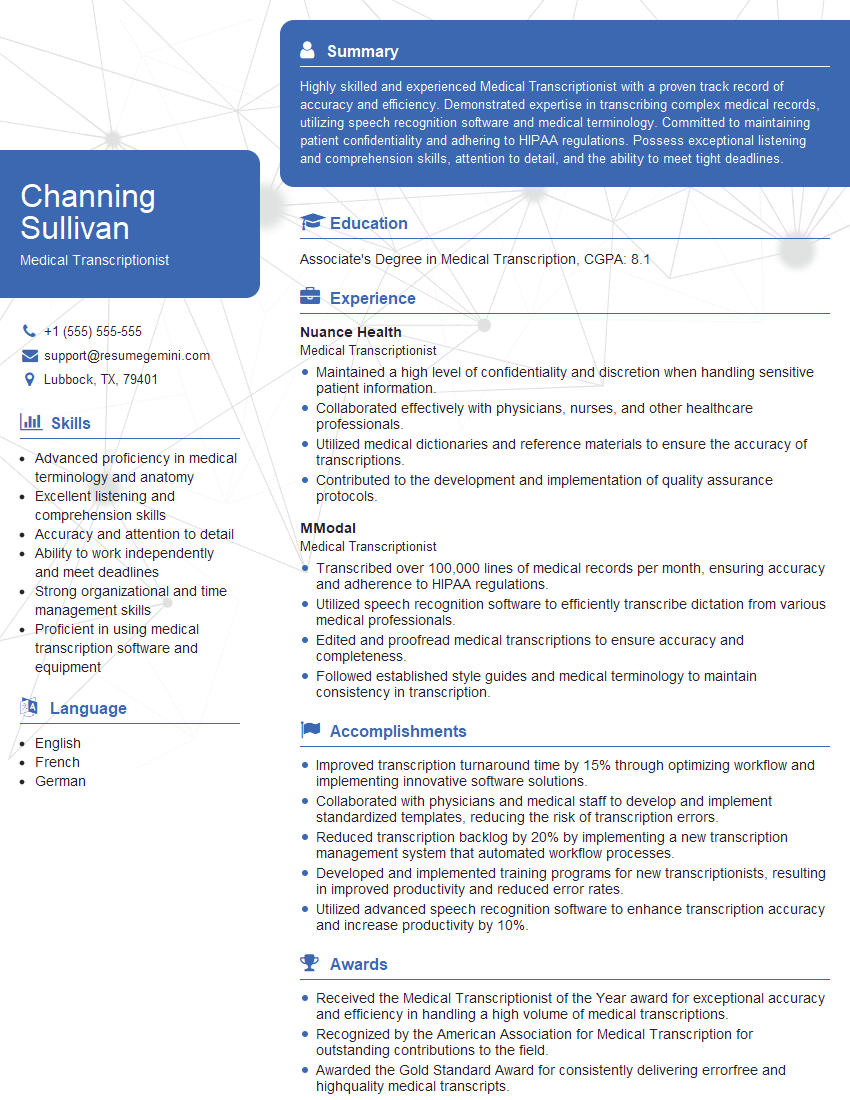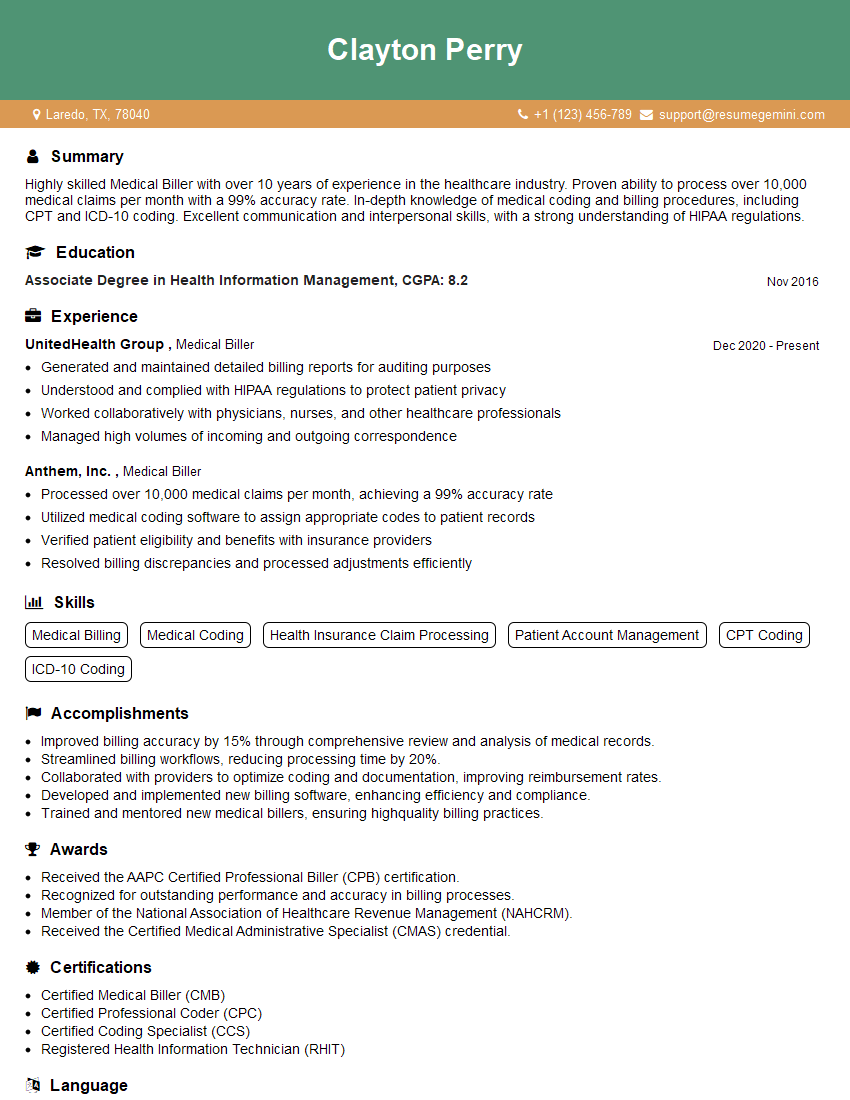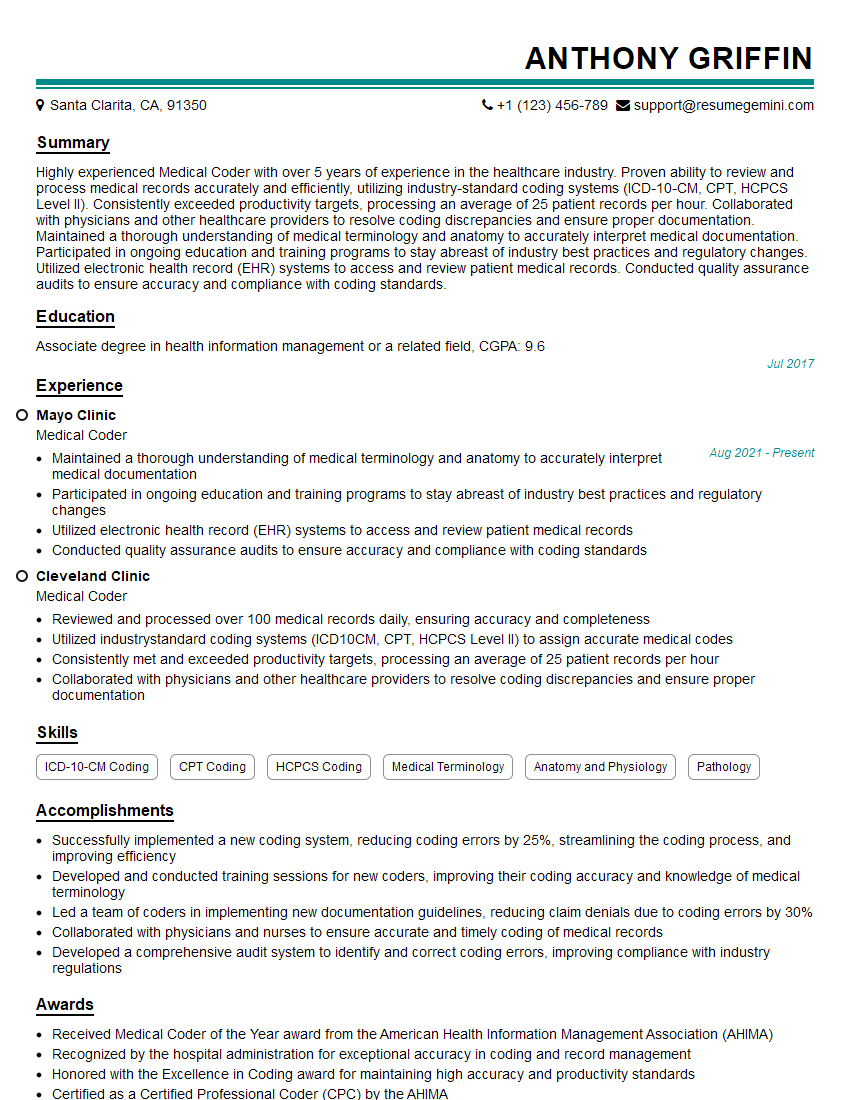Cracking a skill-specific interview, like one for Utilize Medical Terminology and Software, requires understanding the nuances of the role. In this blog, we present the questions you’re most likely to encounter, along with insights into how to answer them effectively. Let’s ensure you’re ready to make a strong impression.
Questions Asked in Utilize Medical Terminology and Software Interview
Q 1. What are the differences between ICD-10 and CPT codes?
ICD-10 and CPT codes are both crucial in medical billing and coding, but serve distinct purposes. ICD-10 (International Classification of Diseases, Tenth Revision) codes are used to classify diagnoses, symptoms, and conditions. Think of them as the ‘what’ of a patient’s visit – the reason for the encounter. For example, a diagnosis of pneumonia might be coded as J18.9, ‘Pneumonia, unspecified organism.’ CPT (Current Procedural Terminology) codes, on the other hand, describe the medical, surgical, and diagnostic services provided. These represent the ‘how’ – the procedures and services performed to treat the diagnosis. An example would be 99213, which represents a specific level of office visit. In essence, ICD-10 codes explain why the patient is seeking care, while CPT codes detail what was done.
The key difference lies in their focus: diagnosis versus procedure. They work together; a claim would typically include both an ICD-10 code for the diagnosis and one or more CPT codes for the services rendered. Accurate use of both is essential for accurate reimbursement.
Q 2. Explain the importance of accurate medical terminology in patient care.
Accurate medical terminology is paramount for safe and effective patient care. Ambiguity in documentation can lead to misdiagnosis, inappropriate treatment, and potentially life-threatening consequences. Imagine a scenario where a nurse misinterprets a physician’s note, leading to a medication error. Precise terminology ensures clear communication among healthcare professionals, reducing errors and improving patient outcomes. For instance, using ‘right upper quadrant pain’ instead of vaguely describing it as ‘stomach ache’ provides more clinical information enabling quicker and more precise diagnostics.
Standardized terminology ensures that all members of the healthcare team are on the same page, facilitating seamless care transitions. It also plays a critical role in epidemiological studies, research, and public health initiatives by allowing for accurate data collection and analysis.
Q 3. Describe your experience with various Electronic Health Record (EHR) systems.
Throughout my career, I’ve worked extensively with several EHR systems, including Epic, Cerner, and Meditech. My experience encompasses data entry, report generation, and system troubleshooting. I’m proficient in navigating different interfaces, understanding their unique functionalities, and adapting to new systems quickly. For instance, while Epic’s charting system is known for its robust functionality, it also has a steeper learning curve than Cerner’s more streamlined interface. My experience allows me to efficiently utilize the strengths of each system while mitigating their limitations. This includes familiarity with different charting styles, order entry processes, and reporting capabilities across various systems. I’m comfortable training colleagues and providing support on various EHR functionalities as needed.
Q 4. How do you handle conflicting information within a patient’s medical record?
Conflicting information in a patient’s medical record requires a methodical approach. First, I would identify the discrepancy and verify the source of each conflicting data point. This might involve reviewing multiple notes from different providers or examining lab results and imaging reports. Then, I’d evaluate the credibility and reliability of the sources, considering the provider’s expertise, documentation quality, and the timing of the information. For example, a recent lab result might supersede an older one. If the conflict remains unresolved, I would consult with the appropriate healthcare professionals (e.g., the treating physician) to clarify the situation and ensure the most accurate information is reflected in the record. Documenting the resolution process is vital to maintain transparency and accountability.
Q 5. What is your familiarity with HIPAA regulations and their impact on medical data?
I am intimately familiar with HIPAA (Health Insurance Portability and Accountability Act) regulations and their impact on medical data. HIPAA mandates the protection of patient health information (PHI), encompassing a wide range of data including medical records, billing information, and even conversations about a patient’s health. My understanding extends to the Privacy Rule, Security Rule, and Breach Notification Rule. I understand the importance of safeguarding PHI through secure data storage, access controls, and appropriate disposal methods. Any breach of HIPAA regulations can have serious legal and ethical ramifications. In my work, I always prioritize data security and adherence to HIPAA guidelines, ensuring that all access to patient data is authorized and documented, minimizing the risk of security breaches.
Q 6. Explain the process of medical coding and billing.
Medical coding and billing is a multi-step process that begins with the physician’s documentation of the patient encounter. This documentation includes the diagnosis (ICD-10 codes) and the procedures performed (CPT codes). A medical coder then reviews this documentation and assigns the appropriate codes. This requires a deep understanding of medical terminology, coding guidelines, and payer-specific requirements. Each code is assigned a specific reimbursement rate by the payer (insurance company or government agency). The coding information is used to create a medical claim, which is then submitted to the payer for reimbursement. The billing process involves tracking claims, managing denials and appeals, and generating reports for financial analysis. Accurate coding and billing is crucial for timely reimbursement and overall revenue cycle management.
Q 7. How do you ensure data integrity and accuracy in medical software applications?
Data integrity and accuracy in medical software applications are crucial for patient safety and efficient healthcare operations. Several strategies contribute to this goal. First, robust data validation rules within the software prevent inaccurate or inconsistent data entry. For example, preventing entry of illogical data like a patient’s age being negative. Second, regular data backups and disaster recovery plans ensure that data is protected against loss or corruption. Third, comprehensive auditing trails allow for tracking data modifications and identifying potential errors. Regular data cleansing and reconciliation processes remove duplicates and correct inconsistencies. Finally, ongoing staff training on proper data entry and software usage are critical to maintaining data integrity. A multi-faceted approach, combining technical safeguards with human diligence, is required to ensure the accuracy and reliability of medical data.
Q 8. Describe your experience with medical terminology software and databases.
My experience with medical terminology software and databases is extensive. I’ve worked extensively with systems like MedDRA (Medical Dictionary for Regulatory Activities), SNOMED CT (Systematized Nomenclature of Medicine – Clinical Terms), and LOINC (Logical Observation Identifiers Names and Codes). I’m proficient in using these databases to map clinical concepts to standardized codes, ensuring accurate data entry and retrieval. For instance, I’ve utilized MedDRA to code adverse events in clinical trials, ensuring consistency and comparability across studies. My experience also includes working with electronic health record (EHR) systems, where I’ve used integrated terminology systems to improve data quality and facilitate clinical decision-making. I’m comfortable querying databases, extracting relevant information, and validating data integrity. I understand the nuances of different coding systems and their applications within various healthcare settings.
For example, I’ve used LOINC codes to analyze laboratory results, enabling efficient aggregation and interpretation of large datasets. My work has involved both using pre-existing databases and contributing to the development and refinement of custom terminological resources within specific organizations. This includes developing controlled vocabularies and mapping between different terminology systems to ensure interoperability.
Q 9. How do you stay updated on changes in medical terminology and coding guidelines?
Staying current in medical terminology and coding guidelines is crucial. I achieve this through a multi-pronged approach. Firstly, I subscribe to and actively read journals like the American Medical Informatics Association (AMIA) publications and those from the Centers for Medicare & Medicaid Services (CMS) to remain informed about updates to ICD (International Classification of Diseases) codes and CPT (Current Procedural Terminology) codes. Secondly, I participate in professional development activities, including webinars and conferences focused on medical coding and terminology. These events often feature presentations by leading experts and provide opportunities for networking and learning about best practices. Thirdly, I utilize online resources provided by organizations like the National Library of Medicine (NLM) to access the latest updates and guidance on medical terminology. Finally, I actively participate in online communities and forums dedicated to medical coding and terminology, allowing me to share knowledge and stay informed about emerging trends and challenges.
Q 10. What is your experience with data analysis in a healthcare setting?
My data analysis experience in healthcare settings involves extracting, cleaning, and analyzing data from various sources, including EHRs, claims databases, and clinical trial data. I’m proficient in using statistical software such as R and SAS to perform descriptive, inferential, and predictive analyses. I’ve worked on projects involving patient cohort identification, risk stratification, and outcome analysis. For example, I analyzed patient data to identify risk factors for hospital readmission, which informed the development of targeted intervention programs. I have experience working with large datasets and using techniques such as data mining and machine learning to extract meaningful insights. I’m also skilled in visualizing data using tools like Tableau and Power BI to effectively communicate findings to both clinical and administrative audiences. I understand the importance of data privacy and security, ensuring compliance with regulations such as HIPAA.
Q 11. How would you troubleshoot a problem with medical software?
Troubleshooting medical software involves a systematic approach. My first step is to identify the specific nature of the problem. This might involve checking error messages, reviewing logs, or talking to users to gather more information. I then try to reproduce the problem to understand the circumstances under which it occurs. Once I have a clear understanding of the problem, I consult the software’s documentation, troubleshooting guides, and online resources to see if the issue is known or if a solution already exists. If the problem is not documented, I use debugging techniques, which may involve stepping through the code or using diagnostic tools to pinpoint the source of the error. If the problem persists, I escalate the issue to the appropriate technical support team. In cases where there is a data integrity issue within the software (like a mismatch between clinical information and associated codes), I would review the source data and the mapping rules, often working with clinical personnel to validate the correct terminology and codes. If necessary, I’ll also use data validation techniques to verify the integrity and completeness of data inputted into the system.
Q 12. Explain the importance of proper documentation in medical records.
Proper documentation in medical records is paramount for several reasons. It ensures continuity of care, facilitates effective communication among healthcare providers, supports accurate billing and reimbursement, and protects patients and providers from legal liabilities. Incomplete or inaccurate documentation can lead to misdiagnosis, treatment errors, and poor patient outcomes. It is also critical for research and quality improvement initiatives. For instance, well-documented progress notes allow for accurate tracking of a patient’s response to treatment, helping to make informed decisions about future care. Furthermore, comprehensive documentation ensures legal protection for both the patient and the healthcare providers, protecting against claims of negligence or malpractice. Consistent adherence to standardized guidelines and terminology is key to ensuring the quality and usefulness of medical records.
Q 13. Describe your experience with different types of medical reports.
My experience encompasses various medical report types. This includes progress notes, discharge summaries, consultation reports, operative reports, pathology reports, radiology reports (including CT scans, MRIs, and X-rays), and diagnostic test results. I understand the specific content and format conventions of each report type and how they contribute to a patient’s overall medical record. For example, I’m familiar with the standardized elements of an operative report, including the indication for surgery, the surgical procedure performed, complications encountered, and the postoperative plan. Similarly, I understand how to interpret and analyze the findings reported in pathology or radiology reports, ensuring that all relevant information is captured and used appropriately in clinical decision-making. My proficiency lies not just in understanding the format, but also in interpreting the information within context and ensuring it aligns with other patient data.
Q 14. How familiar are you with various medical specialties and their associated terminology?
I possess a broad understanding of various medical specialties and their associated terminology. My knowledge extends across fields such as cardiology (e.g., ECG interpretations, cardiac catheterization reports), oncology (cancer staging, treatment protocols), neurology (neurological exam findings, EEG interpretations), gastroenterology (endoscopy reports, bowel disease classifications), and orthopedics (fracture classifications, surgical techniques). This knowledge is not limited to mere terminology; I also understand the clinical implications of these terms and their relevance within their respective specialities. This allows me to accurately interpret medical reports, identify potential inconsistencies, and assist in data analysis across different specialties. For instance, I can differentiate between various types of heart conditions described in a cardiology report and understand how these conditions might interact with other health issues mentioned in a gastroenterology report. This integrated understanding of medical specialties is crucial for accurate data analysis and effective communication across the healthcare continuum.
Q 15. What is your approach to learning new medical terminology?
Learning medical terminology is an ongoing process that requires a multifaceted approach. I utilize a combination of techniques to ensure thorough understanding and retention. Firstly, I leverage structured learning resources such as medical dictionaries (e.g., Stedman’s Medical Dictionary), textbooks, and online courses focusing on medical terminology and anatomy. I find that actively engaging with these resources, highlighting key terms, and creating flashcards significantly aids memorization.
Secondly, I employ contextual learning. I actively seek opportunities to apply newly learned terms within real-world medical contexts. This could involve reviewing medical reports, charting, or participating in discussions with healthcare professionals. Seeing the terms used in practice greatly reinforces understanding. Finally, I rely on mnemonic devices and root word analysis to break down complex terms into more manageable components. For example, understanding the root ‘cardio’ (heart) allows me to quickly grasp the meaning of terms like ‘cardiomyopathy’ or ‘cardiovascular’. This systematic approach allows for continuous growth and proficiency in medical terminology.
Career Expert Tips:
- Ace those interviews! Prepare effectively by reviewing the Top 50 Most Common Interview Questions on ResumeGemini.
- Navigate your job search with confidence! Explore a wide range of Career Tips on ResumeGemini. Learn about common challenges and recommendations to overcome them.
- Craft the perfect resume! Master the Art of Resume Writing with ResumeGemini’s guide. Showcase your unique qualifications and achievements effectively.
- Don’t miss out on holiday savings! Build your dream resume with ResumeGemini’s ATS optimized templates.
Q 16. Describe your experience with medical transcription software.
My experience with medical transcription software encompasses a wide range of applications, including both general-purpose transcription software and specialized medical transcription platforms. I’m proficient in using software such as Nuance Dragon Medical, M*Modal Fluency, and various cloud-based transcription services. My skills extend beyond simple transcription; I am adept at utilizing advanced features such as voice recognition customization, built-in medical dictionaries, and quality assurance tools. For instance, I frequently use the spell-check and auto-correction features within Nuance Dragon to ensure accuracy and efficiency. I also leverage the software’s ability to create custom vocabularies to improve the accuracy of transcription for specialized medical fields or individual physicians’ unique terminology.
Moreover, I am experienced with the workflow involved in using these programs, including audio file management, document formatting, and quality control measures specific to medical transcription – like ensuring HIPAA compliance.
Q 17. How do you prioritize tasks when dealing with multiple urgent requests?
Prioritizing tasks when faced with multiple urgent requests requires a systematic approach. I typically use a combination of techniques including urgency assessment, task dependency analysis, and time management strategies. Firstly, I assess each request based on factors such as clinical urgency, regulatory deadlines, and potential impact on patient care. For example, a request related to a critical lab result would naturally take precedence over a less time-sensitive request.
Secondly, I analyze task dependencies to ensure efficient workflow. If one task needs to be completed before another can begin, I will prioritize accordingly. Thirdly, I employ time management techniques such as time blocking and the Eisenhower Matrix (urgent/important matrix). This helps me allocate my time effectively and ensure that high-priority tasks receive immediate attention. Regular communication with colleagues and stakeholders is vital to keep everyone informed and manage expectations.
Q 18. How do you handle discrepancies between clinical documentation and coding requirements?
Discrepancies between clinical documentation and coding requirements require careful investigation and resolution. My approach involves a methodical process that starts with identifying the specific discrepancy. I meticulously compare the clinical documentation (e.g., physician’s notes, lab results, imaging reports) with the relevant coding guidelines (e.g., ICD-10, CPT, HCPCS). This often requires a thorough understanding of both medical terminology and coding conventions.
Once the discrepancy is clearly identified, I attempt to resolve it through clarification. This might involve reviewing additional documentation, consulting with physicians or other healthcare professionals, or using official coding resources for clarification. In cases where the discrepancy cannot be resolved through clarification, I carefully document the issue and escalate it to the appropriate supervisor or compliance officer. This ensures proper documentation and prevents potential coding errors or billing issues.
Q 19. What quality control measures do you use when working with medical data?
Quality control is paramount when working with medical data. My quality control measures include multiple layers of checks and balances. Firstly, I employ data validation checks at every stage of the process, ensuring data integrity and accuracy. This includes verifying data types, ranges, and consistency across different data sources. For example, I would verify that age is a numerical value within a reasonable range and that dates are correctly formatted.
Secondly, I utilize cross-referencing and comparison techniques to identify discrepancies or inconsistencies in the data. I might compare data entered by different users or cross-check data against external sources, like hospital databases or lab results. Thirdly, I leverage automated quality checks using software tools that provide automated data validation and anomaly detection. Lastly, regular internal audits and external compliance reviews are performed to assess the effectiveness of quality control measures and ensure compliance with regulatory requirements.
Q 20. Describe your experience with data migration and conversion in EHR systems.
My experience with data migration and conversion in EHR systems involves understanding the complexities of moving large amounts of patient data between different systems. This process demands meticulous planning and execution. It begins with a thorough data assessment, identifying the data sources, formats, and structures. I then develop a detailed migration plan that outlines the steps involved, including data cleaning, transformation, and validation. The plan needs to consider potential challenges, such as data integrity issues, data loss, and downtime.
During the actual migration, I employ a phased approach, starting with smaller data sets to test the process and address potential problems before migrating the entire dataset. I leverage data mapping tools to map data elements from the source system to the target system, ensuring accurate data transformation and minimizing errors. Post-migration, I conduct thorough validation and testing, comparing data in the new system to the original data to identify any discrepancies and ensure data integrity. This meticulous process is crucial for successful and seamless data migration, preventing errors and ensuring patient safety.
Q 21. How do you ensure the security and confidentiality of patient health information?
Ensuring the security and confidentiality of patient health information (PHI) is my top priority and requires adherence to strict protocols and regulations such as HIPAA. My approach involves multiple layers of security measures. Firstly, I strictly follow the organization’s security policies and procedures regarding access control, data encryption, and data disposal. This includes using strong passwords, adhering to access control lists, and ensuring all data is appropriately encrypted both in transit and at rest.
Secondly, I regularly update my knowledge of data security best practices and relevant regulations. I am familiar with the latest threats and vulnerabilities and take necessary precautions to mitigate risks. Thirdly, I am trained on identifying and reporting potential security breaches, escalating such incidents immediately to the appropriate security personnel. Finally, I always prioritize patient privacy in all my work, handling PHI with utmost care and discretion, only accessing and using data necessary for my assigned tasks.
Q 22. What is your experience with medical billing software?
My experience with medical billing software spans over eight years, encompassing various systems from large enterprise-level solutions like Epic Beaker and Meditech to smaller, specialized platforms. I’m proficient in using these systems for tasks such as claims submission, payment posting, accounts receivable management, and generating reports for financial analysis. I’ve worked with both cloud-based and on-premise systems and am familiar with various functionalities, including electronic health record (EHR) integration, charge capture, and denial management. For example, I streamlined the billing process at my previous clinic by implementing automated claim scrubbing in Epic Beaker, resulting in a 15% reduction in claim denials. I am also adept at troubleshooting technical issues and ensuring data accuracy and compliance with HIPAA regulations.
Q 23. How would you explain a complex medical term to a non-medical professional?
Explaining complex medical terms to non-medical professionals requires clear, concise language and relatable analogies. Let’s take ‘cardiomyopathy,’ for instance. Instead of saying, ‘It’s a disease of the heart muscle,’ which is technically correct but vague, I’d explain it like this: ‘Imagine your heart is like a pump. Cardiomyopathy means the muscle of that pump is weakened or thickened, making it harder for the heart to pump blood efficiently throughout your body. This can lead to fatigue, shortness of breath, or even more serious complications.’ I always ensure to break down complex terms into simpler components, using everyday language and visual aids when possible. For example, I might use a diagram to show how the heart muscle is affected. I also actively seek feedback to ensure understanding and adjust my explanation as needed.
Q 24. Describe a time you had to solve a problem related to medical terminology or software.
At my previous role, we encountered a significant problem with our medical terminology database. A software update had introduced inconsistencies in the coding system, leading to incorrect billing and potential compliance violations. I identified the issue by systematically comparing claim data before and after the update, noting discrepancies in the codes used for specific procedures. To resolve this, I collaborated with the IT department and the coding team. My approach involved:
- Documentation: I meticulously documented all inconsistencies, including specific codes and their associated errors.
- Data Analysis: I analyzed the data to pinpoint the root cause of the problem in the database.
- Collaboration: I collaborated with the IT team to identify the faulty software update and the coding team to validate the corrected codes.
- Testing and Verification: Once the issue was resolved by the IT team, I rigorously tested the system, ensuring that the coding errors were successfully addressed before re-implementing the process.
This systematic approach allowed us to rectify the problem quickly and minimize any negative financial or compliance impacts.
Q 25. What are the key differences between various medical coding systems?
The key differences between medical coding systems lie primarily in their purpose and the type of information they encode. The most common systems are ICD (International Classification of Diseases) and CPT (Current Procedural Terminology). ICD codes classify diseases and other health problems, while CPT codes describe medical, surgical, and diagnostic procedures. Here’s a breakdown:
- ICD (e.g., ICD-10-CM): Used for diagnosis coding. It’s a highly detailed, alphanumeric system that categorizes diseases and conditions. Example:
I25.10(Unspecified acute myocardial infarction). - CPT (e.g., CPT-4): Used for procedural coding. It provides a comprehensive listing of medical, surgical, and diagnostic services. Example:
99213(Established patient office visit). - HCPCS (Healthcare Common Procedure Coding System): Expands on CPT, including codes for supplies, equipment, and services not covered by CPT. Example:
A4258(Certain types of splints).
Understanding these differences is crucial for accurate billing and data analysis in healthcare. Each system has its own structure and rules, ensuring consistency in medical recordkeeping and financial reporting. Choosing the appropriate code for the specific service or condition is vital for regulatory compliance and reimbursement.
Q 26. What is your experience with medical record audits?
My experience with medical record audits involves both conducting audits and preparing for them. I’ve participated in chart reviews to ensure compliance with regulatory standards, accuracy of coding, and completeness of documentation. I’m proficient in using various auditing software tools and methods. For instance, I’ve used random sampling techniques to review a representative sample of patient charts for specific coding practices or documentation issues. Moreover, I understand the importance of maintaining audit trails and securely storing audit documentation according to HIPAA regulations. I’ve been involved in audits that have identified areas for improvement in clinical documentation leading to improved coding practices and revenue cycle management. This experience has made me highly aware of the importance of proper recordkeeping practices from both a compliance and an operational perspective.
Q 27. How do you ensure compliance with regulatory requirements for medical records?
Ensuring compliance with regulatory requirements for medical records involves a multifaceted approach. This includes adhering to HIPAA (Health Insurance Portability and Accountability Act) regulations regarding patient privacy and data security. I follow strict procedures for data access control, implementing strong password policies and using encryption when transferring sensitive data. I also ensure that all staff receive regular training on HIPAA compliance and maintain accurate documentation of all patient interactions. We utilize a robust system for managing electronic health records, which includes features like audit trails, access controls, and encryption. Furthermore, we regularly update our systems and processes to stay abreast of the latest regulatory changes. We conduct internal audits to identify potential vulnerabilities and promptly address any compliance gaps. Maintaining compliance is not a one-time activity, but an ongoing process requiring constant vigilance and proactive measures.
Q 28. How do you handle pressure and meet deadlines in a fast-paced healthcare environment?
The healthcare environment is inherently fast-paced, demanding the ability to handle pressure and meet deadlines effectively. My approach involves prioritizing tasks based on urgency and importance. I utilize time management techniques like creating detailed to-do lists and scheduling my work effectively. I also rely heavily on efficient software and workflows. For instance, utilizing automated billing systems helps ensure quick and accurate claim submissions. Moreover, I collaborate effectively with my colleagues, leveraging team expertise to solve problems and meet shared deadlines. When faced with challenging situations, I remain calm and focused, utilizing problem-solving skills to address any roadblocks. I always communicate proactively with stakeholders, keeping them informed of progress and any potential challenges. Maintaining a positive attitude and focusing on solutions, rather than dwelling on problems, are key to success in this environment.
Key Topics to Learn for Utilize Medical Terminology and Software Interview
- Medical Terminology Foundations: Understanding prefixes, suffixes, and root words; accurately interpreting medical reports and documentation; applying knowledge to various clinical settings.
- Common Medical Software Applications: Familiarity with Electronic Health Records (EHR) systems, practice management software, and other relevant healthcare IT tools; demonstrating proficiency in data entry, retrieval, and analysis.
- Data Integrity and Confidentiality: Understanding HIPAA regulations and best practices for maintaining patient data privacy and accuracy; explaining procedures for handling sensitive information.
- Coding and Billing Processes: Knowledge of medical coding systems (e.g., ICD, CPT); understanding the revenue cycle and billing procedures; demonstrating ability to identify and resolve coding discrepancies.
- Problem-solving and Critical Thinking: Analyzing complex medical scenarios; identifying potential errors in documentation or data; applying problem-solving skills to improve efficiency and accuracy.
- Workflow Optimization: Identifying opportunities to streamline processes; suggesting improvements to software usage or data management; demonstrating an understanding of workflow in a healthcare setting.
Next Steps
Mastering medical terminology and software is crucial for career advancement in the healthcare industry, opening doors to diverse and rewarding roles. A strong understanding of these areas demonstrates competence and efficiency, making you a highly sought-after candidate. To maximize your job prospects, it’s essential to create a professional and ATS-friendly resume that highlights your skills effectively. ResumeGemini is a trusted resource to help you build a compelling resume that showcases your expertise. We provide examples of resumes tailored to Utilize Medical Terminology and Software to guide you in creating your own standout application.
Explore more articles
Users Rating of Our Blogs
Share Your Experience
We value your feedback! Please rate our content and share your thoughts (optional).
What Readers Say About Our Blog
Hi, I have something for you and recorded a quick Loom video to show the kind of value I can bring to you.
Even if we don’t work together, I’m confident you’ll take away something valuable and learn a few new ideas.
Here’s the link: https://bit.ly/loom-video-daniel
Would love your thoughts after watching!
– Daniel
This was kind of a unique content I found around the specialized skills. Very helpful questions and good detailed answers.
Very Helpful blog, thank you Interviewgemini team.
